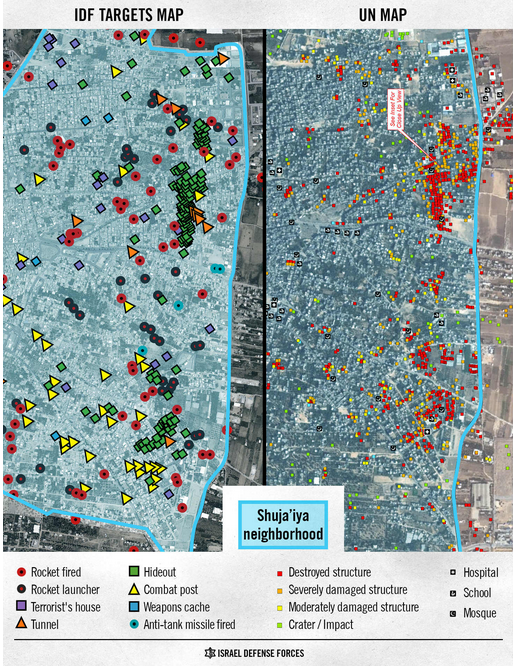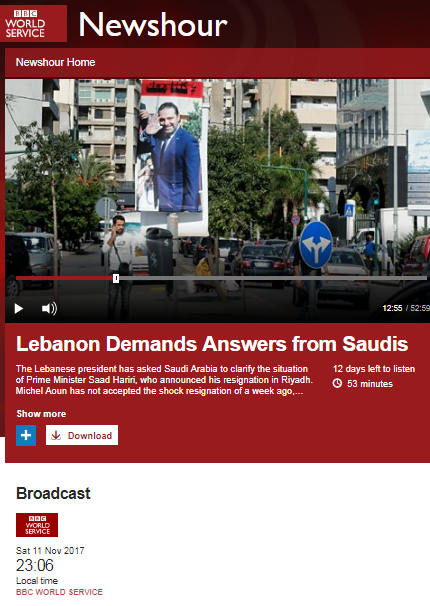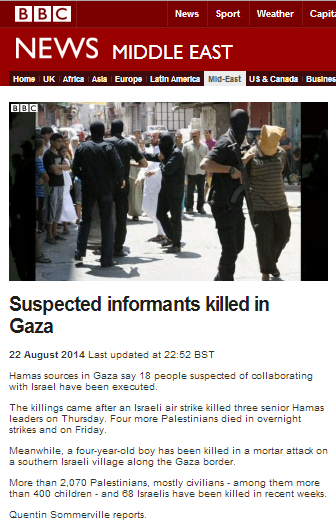On September 1st the BBC News website published a feature titled “Gaza crisis: Toll of operations in Gaza” which has since become a frequent appendage to numerous other articles published on the website’s Middle East page. As we know, the BBC has stated that its online content is intended to act as “historical records” and hence the accuracy and impartiality of that content is of prime importance.
This particular feature opens with the following words:
“The number of civilians killed during Israel’s Operation Protective Edge offensive has raised international concern and condemnation.
Between 8 July and 27 August, more than 2,100 Palestinians were killed in the Gaza Strip, along with 66 Israeli soldiers and seven civilians in Israel.
The UN says the vast majority of Palestinian deaths are civilian. But figures from previous operations over the past six years in the densely populated Gaza Strip show it is not the first time civilians have paid a heavy price.”
Once again we see the BBC quoting “the UN” as though that body were impeccably objective, but with no effort made to inform audiences with regard to the very significant issue of the background to those UN statements and the political motivations involved.
The feature then goes on to address the topic of casualties in three conflicts in reverse chronological order. First comes a section titled “2014: Operation Protective Edge” in which readers are told that:
“The overwhelming majority of those killed were Palestinians.
The UN says at least 2,104 Palestinian died, including 1,462 civilians, of whom 495 were children and 253 women.
An Israeli government official told the BBC that the Israel Defense Forces (IDF) had killed 1,000 “terrorists” during the assault on Gaza.”
No effort is made to inform BBC audiences, for example, of the ongoing analysis being carried out by the Meir Amit Intelligence and Terrorism Information Centre which, after examination of some 35% of the named casualties, so far indicates that the ratio of combatants to civilians stands at 49% to 51% respectively.
The section goes on to present graphics including one complied on the basis of information provided, inter alia, by the Hamas-run Gaza Ministry of Health and “Al Akhbar” – an anti-Israel Lebanese online media organization considered by some to be pro-Hizballah. It further includes ‘analysis’ from the BBC’s head of statistics who – as readers may recall – was forced to radically amend a previous article on the topic of casualties in the Gaza Strip due to outside pressure from politically motivated organisations.

The section goes on to state that “[s]atellite images released by the United Nations show how a section of Shijaia [sic] neighbourhood in Gaza City has been razed by attacks since 8 July” but no attempt is made to provide BBC audiences with the all-important context behind those images by informing them of the military installations deliberately placed by Hamas and other terrorist organisations in that neighbourhood.
The feature then moves on to a section titled “2012: Operation Pillar of Defense” in which readers are informed that:
“Israel’s previous major air strike offensive on Gaza was Operation Pillar of Defense in November 2012.
It began with an air strike that killed the commander of Hamas’s military wing, Ahmed Jabari, whom it accused of responsibility for “all terrorist activities against Israel from Gaza” over the past decade.
Prior to the operation, there had been spates of Palestinian militant groups, including Hamas’s Qassam Brigades, firing hundreds of rockets into southern Israel and the Israeli military shelling Gaza and carrying out air strikes.”
In other words, the BBC continues its now well-entrenched practice of downplaying the months of terror attacks which preceded – and caused – Operation Pillar of Defense. Casualty figures promoted in that section come from one source alone:
“An Israeli human rights group, B’Tselem, said 167 Palestinians were killed, including 87 civilians. Six Israelis – two soldiers and four civilians – were also killed.”
Detailed examination of the names of casualties by the Meir Amit Intelligence and Terrorism Information Centre put the ratio of combatants to civilians at 60:40 compared to B’Tselem’s 52% civilian casualty rate.
The feature’s third and final section is titled “2008-2009: Operation Cast Lead” and it opens with the (apparently copy pasted) claim that:
“The last time Israeli ground troops went into Gaza was in December 2008, as part of Operation Cast Lead. Around 1,391 Palestinians were killed, including an estimated 759 civilians, according to B’Tselem. Reports say this included 344 children and 110 women.” [emphasis added]
The section goes on to promote two more politically motivated NGOs and to advance the myth of the use of white phosphorous as a weapon during Operation Cast Lead.
“Israel’s military had put the overall Palestinian death toll at 1,166, of whom it said 295 were “uninvolved” civilians. The Palestinian Centre for Human Rights estimates that 1,417 Palestinians died, 926 of whom were civilians.
An Amnesty International report into the operation said lives were lost because Israeli forces “frequently obstructed access to medical care.” It also condemned the use of “imprecise” weapons such as white phosphorous and artillery shells.”
No mention is made of the fact that Hamas’ Fathi Hamad admitted in a 2010 interview that around half the casualties in that operation were terrorists, thus negating the inaccurate claims made by the PCHR still being promoted by the BBC.
But by far the most egregious aspect of this BBC feature is the fact that it makes no attempt whatsoever to provide BBC audiences with the crucial context of casualty ratios in the Gaza Strip as compared to those in other conflicts.
Let us assume for a moment that the UN figures quoted and promoted by the BBC are correct and that 495 children were killed during Operation Protective Edge and that none of those under 18s (as UNICEF defines child casualties) were in fact operatives for terrorist organisations. Even if we take those figures at face value, the percentage of children killed in the Gaza Strip during the summer of 2014 is, as Ben Dror Yemini has pointed out, considerably lower than the percentage of children killed by coalition forces (including British troops) in Iraq and by NATO forces (also including British troops) in Kosovo.
And even if we take the BBC’s claim that 1,462 (69%) of a total of 2,104 casualties in the Gaza Strip were civilians as being accurate (despite the fact that – as noted above – ongoing analysis suggests that the ratio of civilians to combatants may actually be lower), that would still mean that – as Col. Richard Kemp has pointed out on numerous occasions – there is nothing exceptional about that ratio.
“The UN estimate that there has been an average three-to one ratio of civilian to combatant deaths in such conflicts worldwide. Three civilians for every combatant killed.
That is the estimated ratio in Afghanistan: three to one.
In Iraq, and in Kosovo, it was worse: the ratio is believed to be four-to-one. Anecdotal evidence suggests the ratios were very much higher in Chechnya and Serbia.”
Now let us remind ourselves of the BBC’s opening statement in this feature:
“The number of civilians killed during Israel’s Operation Protective Edge offensive has raised international concern and condemnation.”
That statement would lead any reasonable reader to believe that the number of civilian casualties in the Gaza Strip during Operation Protective Edge was somehow exceptional enough to prompt “international concern and condemnation”. The BBC’s editorial decision to omit from this feature any comparison to other conflicts means that audiences are unable to put that statement into its correct perspective and are hence likely to be misled.
Of course that editorial decision will not come as much of a surprise to anyone who closely followed BBC coverage of Operation Protective Edge throughout its duration because one dominant theme discernible throughout that coverage was the inaccurate portrayal of the conflict as an Israeli attack upon the civilian population of the Gaza Strip. The feature tells readers that:
“…figures from previous operations over the past six years in the densely populated Gaza Strip show it is not the first time civilians have paid a heavy price”
Indeed the price paid by Gaza’s civilian population for the actions of terrorist organisations embedded in their midst is a “heavy” and regrettable one. However – in contrast to the impression this anonymously written feature deliberately attempts to create – it is nevertheless no heavier than that paid by civilian populations in conflict zones elsewhere in the world. The BBC’s decision not to inform its audiences of that fact can only be attributed to political motivations being allowed to trump editorial standards of accuracy and impartiality.




